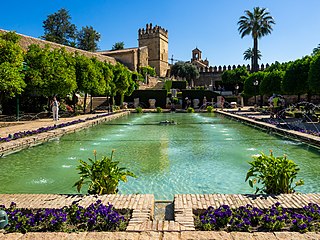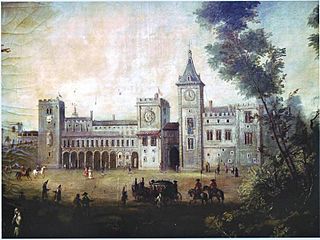
El Escorial, or the Royal Site of San Lorenzo de El Escorial, or Monasterio de El Escorial, is a historical residence of the king of Spain located in the town of San Lorenzo de El Escorial, 2.06 kilometres (1.28 mi) up the valley from the town of El Escorial and about 45 kilometres (28 mi) northwest of the Spanish capital Madrid. Built between 1563 and 1584 by order of King Philip II, El Escorial is the largest Renaissance building in the world. It is one of the Spanish royal sites and functions as a monastery, basilica, royal palace, pantheon, library, museum, university, school, and hospital.

Francisco Gómez de Sandoval y Rojas, 1st Duke of Lerma, 5th Marquess of Denia, 1st Count of Ampudia, was a favourite of Philip III of Spain, the first of the validos through whom the later Habsburg monarchs ruled. His administration was marked by costly wars, including the Twelve Years' Truce with the Dutch Republic, financial mismanagement, and the controversial expulsion of the Moriscos. Eventually, he was deposed in 1618 under a palace intrigue orchestrated by his son and political rival, Cristóbal de Sandoval. Lerma retired as a cardinal and was succeeded by the Count-Duke of Olivares but faced financial penalties and died in 1625 at Valladolid.

The Royal Palace of Madrid is the official residence of the Spanish royal family at the city of Madrid, although now used only for state ceremonies. The palace has 135,000 m2 (1,450,000 sq ft) of floor space and contains 3,418 rooms. It is the largest royal palace in Europe.

Úbeda is a municipality of Spain located in the province of Jaén, Andalusia.

The Alcázar de los Reyes Cristianos, also known as the Alcázar of Córdoba, is a medieval alcázar located in the historic centre of Córdoba, next to the Guadalquivir River and near the Mosque-Cathedral. The fortress served as one of the primary residences of Isabella I of Castile and Ferdinand II of Aragon.

The Royal Palace of El Pardo is one of the official residences of the Spanish royal family and one of the oldest, being used by the Spanish monarchs since Henry III of Castile in the 15th century. It is administered by the Patrimonio Nacional agency and it currently serves as a state guest house.

Luis de Vega was a 16th-century Spanish architect appointed royal architect of Charles I.

The Aljafería Palace is a fortified medieval palace built during the second half of the 11th century in the Taifa of Zaragoza in Al-Andalus, present day Zaragoza, Aragon, Spain. It was the residence of the Banu Hud dynasty during the era of Abu Jaffar Al-Muqtadir. The palace reflects the splendor attained by the Taifa of Zaragoza at its height. It currently houses the Cortes of the autonomous community of Aragon.

The Alcazar of Segovia is a medieval castle located in the city of Segovia, in Castile and León, Spain. It has existed since at least the 12th century, and is one of the most renowned medieval castles globally and one of the most visited landmarks in Spain. It has been the backdrop for significant historical events and has been home to twenty-two kings, along with notable historical figures.

Medrano is a gender-neutral Spanish surname of Basque origin that means "abundance, to grow, to prosper, or to improve". It is a surname of high nobility established in the old Kingdoms of Navarre, Aragon, Castile, France, etc. They are all descendants of their progenitor, Prince Andrés Vélaz de Medrano.

The Royal Audiencia and Chancellería of Valladolid was a judicial body established by Henry II of Castile in 1371, with jurisdiction over the entire territory of the Crown of Castile, except for the characteristics of the Hall of Justice of the Council of Castile. The building was originally called El Palacio de los Vivero.

Francisco de los Cobos y Molina was the secretary of State and Comendador for the kingdom of Castile under the rule of the King Charles I of Spain, who was elected as Holy Roman Emperor in and reigned as Charles V from 1519.

Gonzalo II Fernández de Córdoba, third Duke of Sessa, was the grandson of a Viceroy of Naples, Gonzalo Fernández de Córdoba, first duke of Sessa, the son of the first duke's daughter, Elvira Fernández de Córdoba y Manrique, and of her husband, Luis Fernández de Córdoba. Gonzalo II, holder of several dukedoms and many other lesser titles, Spanish and Italian, was Captain General of the Spanish Troops in Italy, Great Admiral of the Kingdom of Naples, and a member of the Spanish king Royal Council for Italy and the Royal War Council.
Manuel de los Cobos, 4th Marquess of Camarasa,, was a Spanish aristocrat.

Purism is an initial phase of Renaissance architecture in Spain, which took place between 1530 and 1560, after Isabelline Gothic and prior to the Herrerian architecture in the last third of the 16th century. The name "Prince Philip" refers to the period in which Philip II of Spain had not yet received the inheritance of the Spanish Monarchy by abdication of his father, the Emperor Charles V (1556). The name "Serlian" is due to the influential architect and treatise Sebastiano Serlio.

The Archbishop's Palace of Seville is a palace in Seville, Spain. It has served as the residence of bishops and archbishops of the episcopal sees and numerous nobleman and military figures to the present time. It is located in the southern section of Seville, in the Plaza Virgen de los Reyes, angled almost opposite the Giralda. It is situated on the northeastern side of Seville Cathedral in the neighborhood of Santa Cruz. Of Spanish Baroque architectural style, it has had the status of National Monument since 1969.

Andrés López Polanco, was a Spanish Baroque painter specializing in portraits. Documented in Madrid between 1608 and 1641, he worked for the court of King Philip III of Spain and King Philip IV of Spain. His exact date of birth is unknown.

The now demolished Del Real Palace or Royal Palace was the former residence of the kings of Valencia in the «Cap i Casal» of the kingdom, as the city of Valencia was then called. It was on the left bank of the Turia River, where nowadays Jardines del Real are. It was also known as «300 keys palace» in reference to the number of rooms it had at its height.

The Palacio de la Ribera was the summer residence of Philip III in Valladolid. It was built in the 17th century (1602-1605) as part of a process of urban transformation upon the establishment of the Spanish Court in Valladolid between 1601 and 1606. The palace was situated at the Huerta del Rey neighborhood, located across the Parque de las Moreras on the right bank of the Pisuerga river. The palace grounds extended from the Puente Mayor to Ribera de Don Periáñez del Corral and delimited at both sides by the Pisuerga river and the Camino del Monasterio del Prado. The palace was gradually abandoned until it became part of the destroyed cultural heritage of Valladolid in 1761. Some ruins of the building are still preserved.

Palacio de Pimentel is a former royal palace in the city of Valladolid in Castilla y León, Spain. It is located on the Plaza de San Pablo and is one of a number of palaces in Valladolid. It currently serves as the headquarters of the Valladolid Provincial Council.
























